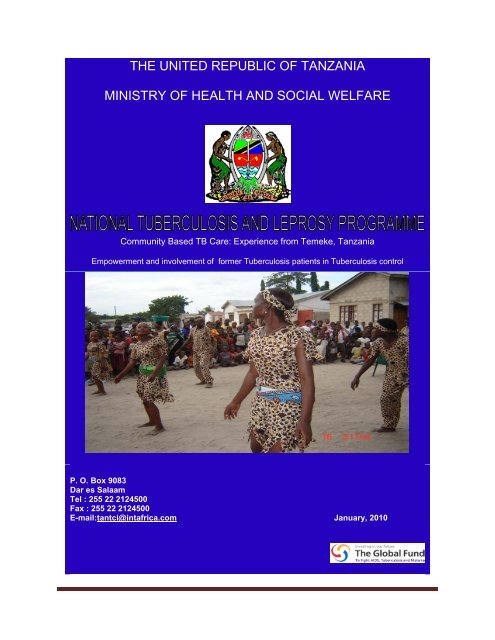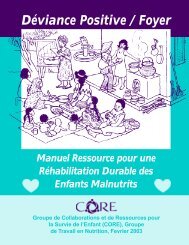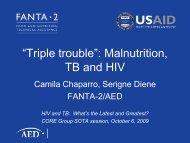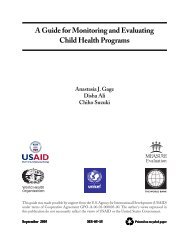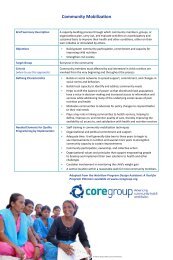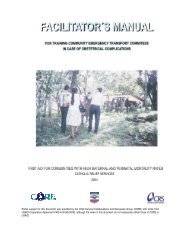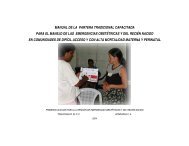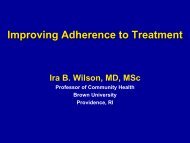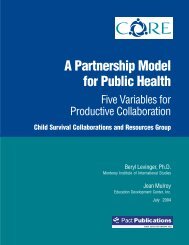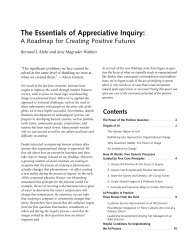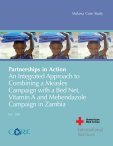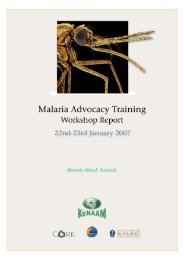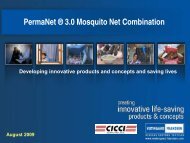Community-Based TB Care: Experience from ... - CORE Group
Community-Based TB Care: Experience from ... - CORE Group
Community-Based TB Care: Experience from ... - CORE Group
You also want an ePaper? Increase the reach of your titles
YUMPU automatically turns print PDFs into web optimized ePapers that Google loves.
THE UNITED REPUBLIC OF TANZANIAMINISTRY OF HEALTH AND SOCIAL WELFARE<strong>Community</strong> <strong>Based</strong> <strong>TB</strong> <strong>Care</strong>: <strong>Experience</strong> <strong>from</strong> Temeke, TanzaniaEmpowerment and involvement of former Tuberculosis patients in Tuberculosis controlP. O. Box 9083Dar es SalaamTel : 255 22 2124500Fax : 255 22 2124500E-mail:tantci@intafrica.com January, 2010
<strong>Community</strong> <strong>Based</strong> <strong>TB</strong> care through former <strong>TB</strong> patients’ social clubsTable of ContentsList of Abbreviations .................................................................................................................................. iiAcknowledgement ..................................................................................................................................... iiiDr. Saidi. M. Egwaga ....................................................................................... Error! Bookmark not defined.Foreword ..................................................................................................................................................... ivExecutive summary ................................................................................................................................... vi1.0 NATIONAL TUBERCULOSIS AND LEPROSY CONTROL PROGRAMME .................................... 11.1 Organizational structure of NTLP ............................................................................................................ 11.2 Temeke Region ......................................................................................................................................... 11.3 <strong>Community</strong> <strong>Based</strong> <strong>TB</strong> care ...................................................................................................................... 22.1 COMMUNITY BASED <strong>TB</strong> CARE IN TEMEKE ................................................................................. 32.2 Background ................................................................................................................................................ 32.3 MUKIKUTE ................................................................................................................................................. 32.3.1 Objectives of MUKIKUTE ..................................................................................................................... 42.3.2 Organizational structure of (MUKIKUTE) .......................................................................................... 42.3.3 Membership ........................................................................................................................................... 62.3.4 Activities/tasks implemented by MUKIKUTE .................................................................................... 72.3.5 Support <strong>from</strong> Temeke Municipal Council........................................................................................... 82.3.7 Sources of funds for MUKIKUTE ........................................................................................................ 82.3.8 Monetary management within the organization .............................................................................. 102.4 Collaboration between <strong>TB</strong> clinics and MUKIKUTE ............................................................................. 102.5 Benefits obtained ..................................................................................................................................... 112.6 General Achievement ............................................................................................................................. 113.0 LESSONS LEARNT AND RECOMMENDATIONS ........................................................................ 143.1 Lessons learnt .......................................................................................................................................... 143.2 Recommendation .................................................................................................................................... 15References ................................................................................................................................................. 17Annexes ..................................................................................................................................................... 18Annex 1: Terms of Reference (TOR) ................................................................................................................. 18Annex 2: MUKIKUTE membership form ............................................................................................................ 21Annex 3: Referral form to be used by traditional healers ................................................................................ 22Annex 4: Phases for <strong>TB</strong> club establishment ..................................................................................................... 23Annex 5: Job description for former <strong>TB</strong> patients in specified areas .............................................................. 25Annex 6: MUKIKUTE registration certificates ................................................................................................... 27<strong>Experience</strong> <strong>from</strong> TemekePage i
<strong>Community</strong> <strong>Based</strong> <strong>TB</strong> care through former <strong>TB</strong> patients’ social clubsList of AbbreviationsAIDS Acquired Immune-deficiency syndromeCBTC <strong>Community</strong> <strong>Based</strong> Tuberculosis <strong>Care</strong>CTC <strong>Care</strong> and Treatment CentreDAS District Administrative SecretaryDED District Executive DirectorDMO District Medical OfficerDOT Direct Observed TreatmentDOTS Directly Observed Treatment StrategyDTLC District Tuberculosis and Leprosy CoordinatorHBC Home <strong>Based</strong> <strong>Care</strong>KNCV Dutch Tuberculosis AssociationLHL Norwegian Heart and Lung Patients’ AssociationPASADA Pastoral Activities and Services for People Living with HIV/AIDS, Dar es SalaamArchdioceseMDR-<strong>TB</strong> Multi-Drug Resistance of TuberculosisMoHSW Ministry of Health and Social WelfareMUKIKUTE Mapambano dhidi ya Kifua Kikuu na Ukimwi – Temeke (fight againstTuberculosis and HIV/AIDS in Temeke)NTLP National Tuberculosis and Leprosy ProgrammePLHIV People Living with HIVPMTCT Prevention of Mother to Child transmissionRAS Regional Administrative SecretaryRMO Regional Medical OfficerRTLC Regional Tuberculosis and Leprosy CoordinatorTOR Terms of Reference<strong>TB</strong>TuberculosisVCT Voluntary Counseling and Testing<strong>Experience</strong> <strong>from</strong> TemekePage ii
<strong>Community</strong> <strong>Based</strong> <strong>TB</strong> care through former <strong>TB</strong> patients’ social clubsAcknowledgementThis document, “<strong>Community</strong> <strong>Based</strong> <strong>TB</strong> <strong>Care</strong>, Temeke experience” is one of the outputs of theNational Tuberculosis and Leprosy Programme (NTLP) implemented in Temeke, Dar es Salaamby Temeke Municipal Council through <strong>TB</strong> control programme in partnership with the NorwegianHeart and Lung Patients Association (LHL). NTLP would like to thank all those who contributedin one way or another to the success of the programme. Special thanks go to Dr. EliudWandwalo who gave <strong>Community</strong> based <strong>TB</strong> care a priority in his PhD thesis and the LHL whofunded the research and later keeps on financially support former <strong>TB</strong> patients in Temeke.The NTLP would also like to extend more thanks to the DMO, DTLCs, health workers in <strong>TB</strong>centres in Temeke and MUKIKUTE administration for their cooperation during thedocumentation. Likewise, the contribution of all MUKIKUTE members in the whole process ofsupporting <strong>TB</strong> patients and community sensitization cannot go unmentioned.Last but not least, more thanks are extended to the Temeke RTLC, Wailes <strong>TB</strong>/HIV officer andthe DTLC for their valuable contributions towards documentation of best practice of community<strong>Based</strong> <strong>TB</strong> care in Temeke Municipality.<strong>Experience</strong> <strong>from</strong> TemekePage iii
<strong>Community</strong> <strong>Based</strong> <strong>TB</strong> care through former <strong>TB</strong> patients’ social clubsForewordTuberculosis (<strong>TB</strong>) is among the top ten causes of global mortality and morbidity accounting forabout 26% of all preventable deaths. <strong>TB</strong> is the third leading killer of adults behind Malaria andAcquired Immune-deficiency syndrome (AMMP, 2003). In Tanzania more than 63,000 new <strong>TB</strong>patients are notified annually and this is mainly fuelled by HIV epidemic. Other factors likepopulation growth and urban overcrowding have also contributed to this increase. Casedetection has remained below 50% compared to WHO estimates of 70% (Global report, 2009).This under reporting could be due to low community sensitization, stigma, and passive casefinding approach.In Tanzania, <strong>TB</strong> patients are treated under health facility or community based Directly ObservedTreatment (DOT). <strong>Community</strong> based DOT includes choosing a local ‘treatment supporter’ tosupervise the patient when taking medications and encourage them to comply in the wholecourse of treatment. This approach goes beyond the existing health services and enhancesmore allies including cured <strong>TB</strong> patients. <strong>Community</strong>-based approach also empowers andinvolves former <strong>TB</strong> patients in their capacity to help other <strong>TB</strong> patients to overcome difficultiesduring treatment.Successful <strong>TB</strong> treatment requires at least 6-8 months of treatment to ensure cure and preventthe development of multi-drug resistant <strong>TB</strong> (MDR-<strong>TB</strong>). Thus compliance throughout the courseof treatment is of paramount importance.Various studies on involvement of local <strong>TB</strong> treatment supporters conducted in different areasworldwide including Temeke, Tanzania. In Temeke the study involved former <strong>TB</strong> patients.The effectiveness of this approach revealed in 2004 in a randomized controlled trial conductedin Temeke region of NTLP where by the effectiveness of community-based DOT usingguardians and former <strong>TB</strong> patients was done to compare hospital-based DOT in an urban settingin Tanzania. The findings <strong>from</strong> both DOT options gave similar treatment outcomes at a reducedcost. It was therefore concluded that community-based DOT was as effective as health facilitybasedDOT and can achieve good treatment outcomes (Wandwalo et al, 2004).Another study conducted in the same region in 2005 to determine the cost effectiveness ofhealth facility and community based <strong>TB</strong> DOTS in an urban setting in Tanzania revealed that, thetotal cost of treating a patient with conventional health facility based DOT and community basedDOT were $ 145 and $ 94 respectively. Cost fell by 27% for health services and 72% forpatients. Indirect costs were as important as direct costs, contributing to about 49% of the totalpatient's cost. The main reason for reduced cost was less number of visits to <strong>TB</strong> clinics.<strong>Community</strong> based DOT was more cost-effective at $ 128 per patient successfully treatedcompared to $ 203 for a patient successfully treated with health facility based DOT (Wandwaloet al, 2005).These results persuaded NTLP in collaboration with the Norwegian heart and Lung PatientsAssociation (LHL) to establish former <strong>TB</strong> social club known as “Mapambano dhidi ya Kifua kikuuna UKIMWI, Temeke” MUKIKUTE in 2005 for the purpose of strengthening community based<strong>Experience</strong> <strong>from</strong> TemekePage iv
<strong>Community</strong> <strong>Based</strong> <strong>TB</strong> care through former <strong>TB</strong> patients’ social clubsDOT in Temeke municipal council. The club is implementing a lot of activities and it has shownremarkable achievements concerning community based <strong>TB</strong> care.In view of these achievements, the Ministry of Health and Social Welfare (MoHSW) throughNTLP decided to document Temeke experience, best practices and lessons learnt oncommunity based <strong>TB</strong> care and share with different stakeholders. This document will also beused as the base for development of Terms of Reference (TOR) and training package forestablishment and management of former <strong>TB</strong> patients’ clubs in other districts across thecountry.<strong>Experience</strong> <strong>from</strong> TemekePage v
<strong>Community</strong> <strong>Based</strong> <strong>TB</strong> care through former <strong>TB</strong> patients’ social clubsExecutive summaryEmpowering and involving former <strong>TB</strong> patients in improving community <strong>TB</strong> care revealed to bean effective method of increasing <strong>TB</strong> case detection rates as well as improving <strong>TB</strong> treatmentoutcome. It is clearly connected to other priorities in <strong>TB</strong> control.In regards of involving former <strong>TB</strong> patients in community based <strong>TB</strong> care, Temeke was the firstdistrict to establish and maintain a successful former <strong>TB</strong> patients’ group, as the initiative ofimplementing community based <strong>TB</strong> care (CBTC) in the district. This document presents the bestpractices of community based <strong>TB</strong> care in Temeke.Multiple strategies were used to obtain relevant information for this document. The strategiesincluded interviewing the regional <strong>TB</strong> and Leprosy Coordinator of Temeke, health workers in <strong>TB</strong>clinics and administration of MUKIKUTE (former <strong>TB</strong> patients’ organization). Available published,grey literature and reports on the empowerment and involvement of patients and former patientsin <strong>TB</strong> control were also reviewed. The interview covers the general information of theorganization, activities implemented by the organization, roles and responsibilities of members,source of funds as well as on how health workers including Regional and District <strong>TB</strong>coordinators work with and support the group.Cured <strong>TB</strong> patients <strong>from</strong> MUKIKUTE have been working in collaboration with health workers inTemeke NTLP region. They have been involved in social mobilization, providing treatmentsupport to patients under home based DOT, shared their experience with <strong>TB</strong> patients undertreatment brought suspected cases to the <strong>TB</strong> centre and assist <strong>TB</strong> patients to correctly followtheir treatment. Norwegian Heart and Lung patients Association has been providing financialsupport, while Temeke Municipal Council provides financial and technical support.The major lessons learned include community involvement through former <strong>TB</strong> patients’ groupscreated and strengthened the sense of an individual, family and community responsibility in <strong>TB</strong>control. This also empowered the ex-patients to take on an active role in the fight against <strong>TB</strong>;enhancing community awareness through the use of former <strong>TB</strong> patients as informants andtreatment supporters has contributed towards reducing default rates and improving cure rates. Ithas also contributed towards reducing stigma and discrimination of <strong>TB</strong> patients in the family andcommunity. Former <strong>TB</strong> patients’ groups hardly ever empower themselves but need theinvolvement of stakeholders other than the <strong>TB</strong> programme.The document recommends the establishment of former <strong>TB</strong> patients’ club for community <strong>TB</strong>care with major activities of conducting sensitization gatherings and trainings; defaulter and <strong>TB</strong>contact tracing; and supervising patients under home based DOT. Only committed former <strong>TB</strong>patients are recommended for enrolment. A joint plan for CBTC activities between the Councilsand <strong>TB</strong> clubs is also recommended. Health workers are recommended to provide technicalassistance and a maximum cooperation for capacity building among the former <strong>TB</strong> patients fortaking up an active role in the fight against <strong>TB</strong>. <strong>TB</strong> control programme at district level advised toallocate funds, and looking for donors to support former <strong>TB</strong> patients. However, the Councilsadvised to assist clubs in establishing income generating activities for their sustainability.<strong>Experience</strong> <strong>from</strong> TemekePage vi
<strong>Community</strong> <strong>Based</strong> <strong>TB</strong> care through former <strong>TB</strong> patients’ social clubs1.0 NATIONAL TUBERCULOSIS AND LEPROSY CONTROL PROGRAMME1.1 Organizational structure of NTLPThe NTLP is based on the central- local government structure of the MoHSW and that of thePrime Minister’s Office Regional Administration and Local Government (PMORALG). The majoractivities implemented by the NTLP is to mainstream <strong>TB</strong> control activities at lower levels <strong>from</strong>the region, district to community, basing on the stop <strong>TB</strong> strategy including communityinvolvement and patient empowerment.Prime Minister’s OfficeRegional Administration and Local GovernmentMinistry of Health and Social WelfareDirectorate of preventive services(TLCU)RASRMO (RTLC)DAS/DEDDMO (DTLC)In-chargeHealth centreIn-chargeDispensary<strong>Community</strong>Fig 1: Organizational structure of the Tuberculosis and Leprosy control programme1.2 Temeke RegionTemeke is the largest Municipality among of the three Municipalities in Dar es Salaam city,covered 656 sq. km, with the population of 927,310. According to the NTLP, these Municipalitiesare taken as regions. Temeke region is located on southern part of Dar es Salaam city, and ithas seven (7) NTLP districts namely Wailes, Mbagala (Kizuiani), Tambukareli, Kigamboni,Yombo Vituka, Keko and Rangi Tatu. Economically, the population in the rural part of Temeke isengaged in small scale farming, petty trading and fishing. A small proportion of urbaninhabitants are employed by either government, parastatal or informal sector.<strong>Experience</strong> <strong>from</strong> Temeke Page 1
<strong>Community</strong> <strong>Based</strong> <strong>TB</strong> care through former <strong>TB</strong> patients’ social clubs2.0 COMMUNITY BASED <strong>TB</strong> CARE IN TEMEKE2.1 BackgroundTemeke Municipal Council has been involved in community <strong>TB</strong> control particularly former <strong>TB</strong>patients since 1 st July 2003 to date. The collaboration started during the study conducted by Dr.Elliud Wandwalo in the year 2003 which was done collaboratively with Temeke MunicipalCouncil and PASADA. In the study a total number of twenty (20) former <strong>TB</strong> patients recruited(two per district) for the study and later were oriented on <strong>TB</strong> and <strong>TB</strong>/HIV management includingsupervising patients under home based DOT. Each of them was given allowance of 2000/- Tshsper week making a total of 8000/- Tshs per month. The study showed a nice treatment outcomeamong the patints who have been supervised by former <strong>TB</strong> patients. The study funded by LHL.Following these remarkable achievements, Temeke region facilitated the formation of former <strong>TB</strong>patients’ organization known as MUKIKUTE in 2005.Responding to the recorded study results, in year 2006 the region increased the number to 40former <strong>TB</strong> patients. As the demand increased, in year 2008, the region increased the numberup to 60 former <strong>TB</strong> patients. Fifty (50) former <strong>TB</strong> and <strong>TB</strong>/HIV patients out of 60 are currentlyinvolved to support 230 (11%) <strong>TB</strong> patients under home based DOT. According to Temekeregional annual report (CBTC report, 2008) 2,912 patients were registered as new cases andout of this, 2,180 (%) were supervised under home based DOT (Temeke region annual report,2008).The Council allocates about 7,000,000/- Tsh. per year to support community <strong>TB</strong> care activitiesin Temeke.2.2 MUKIKUTEMUKIKUTE is a non–governmental organization working in the community of Temeke Dar-es-Salaam to combat further spread of <strong>TB</strong> and HIV; and mitigate its impact among the communitymembers who are infected.MUKIKUTE was established on 22 nd February 2005 with 20 members who participated in thestudy in 2003 as mentioned earlier. Through the support of Temeke Municipal Council andPASADA in 2007 the organization was legally and officially registered, as a non-governmentalorganization aimed at increasing community knowledge/awareness on <strong>TB</strong> and <strong>TB</strong>/HIV andpromoting positive attitude and support towards people living with HIV (PLWHIV) andTuberculosis. MUKIKUTE stands for “Mapambano ya Kifua Kikuu na Ukimwi – Temeke”,meaning fight against Tuberculosis and HIV/AIDS in Temeke. The organization has aconstitution which it operates on and currently, there are 60 registered members.<strong>Experience</strong> <strong>from</strong> Temeke Page 3
<strong>Community</strong> <strong>Based</strong> <strong>TB</strong> care through former <strong>TB</strong> patients’ social clubs2.2.1 Objectives of MUKIKUTEThe main objectives of MUKIKUTE are:• To create awareness on <strong>TB</strong> and HIV/AIDS among the community members.• To work against <strong>TB</strong> and HIV/AIDS stigma in the community.• To supervise patients who take <strong>TB</strong> drugs under home based DOT.• To assist/encourage <strong>TB</strong> patients to comply and complete treatment.• To create awareness in the community on the proper care of <strong>TB</strong> patients and PLWHIVSupport formation of <strong>TB</strong> clubs in the community.2.2.2 Organizational structure of (MUKIKUTE)Board of DirectorsGeneral AssemblyExecutiveCommitteeManagement TeamFormer <strong>TB</strong> and<strong>TB</strong>/HIV patientsSupporting staffa) b)Fig 2: a) Organizational structure; b) Leadership chart of the club (MUKIKUTE)i) Board of DirectorsThis consists of 2 Doctors including RTLC and any other doctor interested with the clubDuties:- Advisory body- Provide technical Supportii) General assembly:This involves all MUKIKUTE membersSecretaryGeneralPresident/ DirectorsTreasurerCommitteeFormer <strong>TB</strong> and <strong>TB</strong>/HIV patientsSupporting staffDuties- Main decision making organ - approving policies, financial plan, budget andreport.- Selection of six (6) members to form the executive committee- Selection of three (3) signatories of the organization- Approve contributions proposed by the executive committee<strong>Experience</strong> <strong>from</strong> Temeke Page 4
<strong>Community</strong> <strong>Based</strong> <strong>TB</strong> care through former <strong>TB</strong> patients’ social clubsMeetingsThe organization has three types of meetings namely annual general meeting, specialgeneral meeting and extra ordinary meeting. The General meeting is held at least oncein every calendar year usually in the first quarter where by all MUKIKUTE membersattend the meeting. In the event of urgency, the secretary in consultation with theChairperson may call an extra ordinary general meeting of the organization. Specialgeneral meetings convened when there is a special issue to be discussed.All these meetings need a quorum of 50% of eligible members.iii) Executive committeeThe executive committee consists of:o Management teamo Six members selected by the general assemblyDuties:- Run day to day affairs of MUKIKUTE- Prepare annual budget and other budget- Employ and deploy staff- Review of financial reports- Accountable on the organization assets including those hired by the organization- Prepare agenda for the General assemblyThe executive committee meetings take place at least four (4) times per year.iv) Management TeamThese are office bearers and is comprised of three (3) members who areo Chairpersono Secretaryo TreasurerThese are elective positions to run the office for 5 years. Re-election of a member isacceptable. These also are the members of the executive Committee by virtue of theirtitles.Duties:a) Chairperson- Spokesperson of the organization- Convene special and emergence meeting as deemed necessary- Preside meetings and casting votes- Topmost official in the organization who deals with all matters pertaining theorganization and rulesb) Secretary- Chief executive- Prepares and keeps records of all activities of the organization- procure goods and services for the organizationc) Treasurer- Accounting all funds belonging to the organization- One of the four signatories of the organization.<strong>Experience</strong> <strong>from</strong> Temeke Page 5
<strong>Community</strong> <strong>Based</strong> <strong>TB</strong> care through former <strong>TB</strong> patients’ social clubs- Issue all cheques- Keeps all financial records.- Prepare annual statement of accounts for the organizationv) Former <strong>TB</strong> and <strong>TB</strong>/HIV patientsDuties:- Active case finding- Defaulter tracing- Support treatment to <strong>TB</strong> patients under home based DOT- <strong>Community</strong> sensitization as informantsvi) Supporting staffThese include office attendants and driverDuties:- Provide support in various office activities(i) Criteria:2.2.3 MembershipAnybody who has been treated and cured <strong>from</strong> Tuberculosis with/without living with HIV/AIDSand has:• To be ready to give a testimony on being diseased and cured <strong>from</strong> <strong>TB</strong>.• To be ready to give services/support to <strong>TB</strong> patients• Arleady exposed his/her HIV/AIDS seral status to the community.• To be acceptable by the community• To be ready to learn about various issues concerning <strong>TB</strong> and HIV/AIDS.(ii) How to applyAn applicant has to do the following:• Write an application lettero The letter should describe briefly the reason of why he/she want to join.• Fill a membership form under supervision of the secretary general.• Pay an application fee of 10,000/- Tshs• Pay a membership fee is 1,000/- Tshs per month.• Pay any other contributions agreed by the organization (any contribution has to bediscussed by the executive committee and approved by Annual General meeting)(iii) Termination of membershipMember is eligible for termination on the following reasons:• Death• Resignation or retirement in writing• If convicted of criminal offence• Proved mentally un-fit• Misuses of organization money, assets and anything belongs to the organization<strong>Experience</strong> <strong>from</strong> Temeke Page 6
<strong>Community</strong> <strong>Based</strong> <strong>TB</strong> care through former <strong>TB</strong> patients’ social clubs• Failure of paying membership fees consecutively for more than 6 months without anynotice2.2.4 Activities/tasks implemented by MUKIKUTECurrently MUKIKUTE is implementing the following activities:• <strong>Community</strong> mobilization/sensitizationo Conduct meetings and community gatherings in which <strong>TB</strong>, <strong>TB</strong>/HIV and HIV/AIDS factsprovided using former <strong>TB</strong> patient’s testimony and pamphlets, brochures, leaflets.Gatherings conducted at least once per year per ward. Edu-entertainments are usedincluding drama, performance talks, role plays, testimonial <strong>from</strong> former <strong>TB</strong> patients andPLHIV addressing <strong>TB</strong> control; <strong>TB</strong>/HIV; HIV/AIDS and stigma.MUKIKUTE drama group,performing duringcommunity sensitizationevent in one of the wards inTemeke.The MUKIKUTE Chairperson (Mr JosephMapunda), sensitizing the community about <strong>TB</strong>and <strong>TB</strong>/HIV in one of the wards in Temeke.ooSensitize community members/leaders to understand and accept <strong>TB</strong> patients andPLWHIV in the community.Sensitize <strong>TB</strong> suspects; and refer them to health facility for screening and laboratoryinvestigations.<strong>Experience</strong> <strong>from</strong> Temeke Page 7
<strong>Community</strong> <strong>Based</strong> <strong>TB</strong> care through former <strong>TB</strong> patients’ social clubsoVisit <strong>TB</strong> patients and their contacts for education on <strong>TB</strong> signs and symptoms; andencourage the contact to attend at health facilities for screening whenever they show thesigns and symptoms.• Orient and work with traditional healers in identifying and referring patients with <strong>TB</strong> signsand symptoms to health facilities. The former <strong>TB</strong> patients expedite the process of patientsaccessing health facility and discourage <strong>TB</strong> treatment by traditional healers.• Support and supervise <strong>TB</strong> patients under home based DOT• Defaulter tracing - this has been done in collaboration with District <strong>TB</strong> and leprosyCoordinators.2.2.5 Support <strong>from</strong> Temeke Municipal CouncilMUKIKUTE gets support <strong>from</strong> Temeke Municipal council in the following areas:• Collaboration in trainings for community empowerment including refresher training toMUKIKUTE members twice a year on <strong>TB</strong> and <strong>TB</strong>/HIV• <strong>Community</strong> sensitizationo Temeke Municipal through RTLC and DTLCs collaborates with MUKIKUTE incommunity sensitization. Sensitizations conducted in the presence of the Coordinatorsofor responding on technical questions posed by the community.The RTLC facilitate the training on <strong>TB</strong> and <strong>TB</strong>/HIV to influential people includingtraditional healers, Councilors, wards executive officers.• The council has been receiving funds <strong>from</strong> partners and disburses them to MUKIKUTE tillwhen MUKIKUTE registered as legal operating organization. To date the funds <strong>from</strong>partners goes direct to MUKIKUTE.• The Council and MUKIKUTE conduct a joint plan for community based activities to beconducted during a respective financial year.2.2.6 Collaborating partnersMUKIKUTE works collaboratively with the following national and international organizations:− Norwegian Heart and Lung Patients Association (LHL)− National <strong>TB</strong> and Leprosy programme of MOHSW Tanzania− KNCV (Dutch <strong>TB</strong> foundation)− PASADA− Temeke Municipal Council.− ICAP2.2.7 Sources of funds for MUKIKUTEThe organization derives funds and income <strong>from</strong> fees, contributions <strong>from</strong> members, sale ofpublications/properties, gifts, grants, aids <strong>from</strong> donors.• Application and monthly fees <strong>from</strong> members (explained above in 2.2.3 ii)• Contributions <strong>from</strong> members<strong>Experience</strong> <strong>from</strong> Temeke Page 8
<strong>Community</strong> <strong>Based</strong> <strong>TB</strong> care through former <strong>TB</strong> patients’ social clubsSometimes members agree to pay some money for development activities. For example,Kigamboni club contributed the initial cost for flower garden development.• Economic and income generating activitiesMUKIKUTE has created different projects for income generation. These include:o Drama club which has been used for community sensitization and also it usually lent outin different occasionso Lend out generators, modern music system and amplifierso The organization makes “tie and die” clothes (batiks) and sell them for generatingincomeMUKIKUTE members lookingat the “tie and die” clothes(batiks) developed by the club.• Donation <strong>from</strong> other partner organizationLHL has adopted and active supportive role and used a combination of methods andapproaches in its cooperation with MUKIKUTE. These include:o Skills enhancement through seminars, workshops, and training,o Involvement of patients, former <strong>TB</strong> patients and service providers in development of IECmaterials,o Consultative visits by LHL officials to observe the programme activities and meetstakeholders and patients,o Provision of on-site advice, support and mentoring,o Facilitating opportunities for participation in seminars and conferences locally, regionallyand internationally,o Nurturing and promoting local talent/expertise such as in the production of locallyresponsive IEC materials (<strong>TB</strong> booklets).<strong>Experience</strong> <strong>from</strong> Temeke Page 9
<strong>Community</strong> <strong>Based</strong> <strong>TB</strong> care through former <strong>TB</strong> patients’ social clubsBank account2.2.8 Monetary management within the organizationBank account opened by the name of the organization. There are four signatories of theorganization. All revenues of the organization are deposited to the bank. All cheques and ordersfor payments <strong>from</strong> the account have been signed by at least two signatories. The organizationfinancial year ends on 31 st December, every year.2.3 Collaboration between <strong>TB</strong> clinics and MUKIKUTE• <strong>Community</strong> mobilization/sensitizationDuring community sensitization, MUKIKUTE works hand in hand with health personnel includingDTLCs. Before sensitization is done MUKIKUTE and health care providers work together toprepare massages for drama and talks. During the course of sensitization, health care providershave the role of clarifying and responding to issues rose <strong>from</strong> community members.• Orientation/training community leadersDuring training/orientation workshops of influential people which are organised in collaborationbetween MUKIKUTE and Temeke Municipal, health personnel facilitates the trainings.• Selection of treatment supportersSmear positive patients who opt for home based DOT and those who have no relative tosupport them during treatment, health care providers have to communicate with MUKIKUTEleaders for select the treatment supporter <strong>from</strong> the organization who is living closely to thepatient for easy accessibility.• Health educationThis is provided to treatment supporters who come for refill of medications. In Temeke, isprovided on Tuesdays and Thursdays (drug refill days). This helps to remind treatmentsupporters their responsibility and to properly handle patients in different situations. Theeducation is provided by health care providers and one or two selected member(s) <strong>from</strong>MUKIKUTE.• Intensified Case Finding (ICF)MUKIKUTE brings <strong>TB</strong> suspects obtained by either screening <strong>TB</strong> contacts or identifying them<strong>from</strong> the general community (active case finding forms available). Health workers facilitateinvestigations for diagnosis.• Defaulter tracingHealth workers provide a list and addresses of defaulters to MUKIKUTE leaders. The former <strong>TB</strong>patients have been given the responsibility of tracing them basing on their residential locations.The health workers usually accompanied the former <strong>TB</strong> patient and use that opportunity toeducate the whole family and other <strong>TB</strong> contacts.• Health talksHealth workers support former <strong>TB</strong> patients to conduct health talks and give their testimony to<strong>TB</strong> patients at diagnostic and DOT centres. Former <strong>TB</strong> patients assign themselves at least two<strong>Experience</strong> <strong>from</strong> Temeke Page 10
<strong>Community</strong> <strong>Based</strong> <strong>TB</strong> care through former <strong>TB</strong> patients’ social clubsper centre. Prior to the talk, topics are prepared and during the talks Health workers assistformer <strong>TB</strong> patients in responding to questions raised <strong>from</strong> <strong>TB</strong> patients.Health care providers in Temeke Municipal are positively recommending MUKIKUTE and othersmall former <strong>TB</strong> patient’s clubs in <strong>TB</strong> control strategy. They also recommends some moremotivations to them especially some allowances, means of transport like bicycles for thosesupporting patients under home based DOT as well as financing their projects for theirsustainability. For instance, Kigamboni former <strong>TB</strong> patients’ club has established vegetablegarden as income generating activity for the club, but they need funds for buying bicycles forvegetable distribution.2.4 Benefits obtainedTemeke Tuberculosis Programme:Apart <strong>from</strong> community sensitization and training, the council work together with MUKIKUTE indefaulter tracing and active case finding. MUKIKUTE members bring <strong>TB</strong> suspects for sputumexamination and defaulters for treatment. The intensified case finding forms are available in <strong>TB</strong>clinics and MUKIKUTE office.• MUKIKUTE the first ever former <strong>TB</strong> patients’ organization in Tanzania• Retention of all 19 founder members to date in the organization (one died).• Good relationship with partners -LHL, PASADA, Temeke Municipal Council and ICAP• Good reputation- internationally, nationally and the community at large• The organization is able to generate income through hiring of motorcycle, 2 generators,modern music system and amplifier• MUKIKUTE members have been getting some allowances as TOTs in which some amounthave been paid to the organization.Individual benefits• Earned respect <strong>from</strong> health workers and community at large by being TOTs in CBDOT, andhome based HIV management• More knowledge and skills on <strong>TB</strong> and <strong>TB</strong>/HIV control• Some of members do attend international conferences outside the country• Members have acquired knowledge and skills in income generating activities includingmaking of tie and die clothes.2.5 General AchievementTemeke Municipal• The first district to establish former <strong>TB</strong> patients’ organization in Tanzania.• Increased case notification rate (average of 3% of cases per year)• Cure rates increased <strong>from</strong> 78% (2004) to 87.5% (2008)Note: This should be understood that former <strong>TB</strong> patients’ involvement in community <strong>TB</strong> carehas contributed to the above achievements align with other <strong>TB</strong> control activities in Temekemunicipal council.<strong>Experience</strong> <strong>from</strong> Temeke Page 11
<strong>Community</strong> <strong>Based</strong> <strong>TB</strong> care through former <strong>TB</strong> patients’ social clubsMUKIKUTE:Up to the end of the year 2008, the organization has been implementing the followingcommunity <strong>TB</strong> care activities:-• Tracing <strong>TB</strong> contact of smear positive patients• Prepare and print referral forms to be used by traditional healers• Organize training on <strong>TB</strong> and <strong>TB</strong>/HIV to 40 traditional healers and 480 other influentialpeople in 16 wards out of 24 wards in the district.• Organize refresher trainings to 320 former <strong>TB</strong> and <strong>TB</strong>/HIV patients on <strong>TB</strong> and <strong>TB</strong>/HIV.• Conducted community sensitization in all 24 wards in Temeke. More than 6500 peoplesensitized.• Provided community DOT to more than 200 patients• Conducted active case finding, and they managed to bring 601 <strong>TB</strong> suspects for diagnosiswhere by 43 among those were new smear positive <strong>TB</strong> cases.• Developed 5000 booklets to impart knowledge about <strong>TB</strong> among to patients, which haveadopted by the Ministry and other organizations in different countries including Zambia andNamibia.• Promoted <strong>TB</strong> agenda locally and internationally• Other 3 <strong>TB</strong> clubs to including Ilala, Kinondoni Municipalities and Kisarawe district in Pwaniregion have been formed under guidance of MUKIKUTE.• Spear heading establishment of National former <strong>TB</strong> patients’ clubs referred to as “MKUTA”2.6 OpportunitiesMUKIKUTE has managed to achieve its objectives by using the available opportunities toinclude:• Good collaboration with Temeke Municipal Council• National and world commemoration days such as World <strong>TB</strong> and HIV days• Readiness of media organs to work with MUKIKUTE to include TV/Radio talks• Good cooperation with health care providers in conducting Health talks at health facilities• Willingness and availability of partners/stakeholders to work with MUKIKUTE• Political will at different levels to work with MUKIKUTE• Readiness of the community to work with MUKIKUTE2.7 Challenges facing <strong>Community</strong> based care in TemekeTemeke Municipal• Still low community awareness in about <strong>TB</strong> and this has been contributed by the fact thatsome community members do not want to attend the sensitization gatherings.• Stigma to <strong>TB</strong> and <strong>TB</strong>/HIV patients is still high in Temeke• Some treatment supporters send patients to collect weekly drug supplies whenever patientsshow improvement.(identify reasons/ causes of this problem)• Some treatment supporters just provide the drugs for the whole week to the patients for selfsupervision.(state the reasons for this problem)• Some relatives (treatment supporters) think that they are wasting their time when waiting forthe refill of drugs for their patients• Shortage of health care providers results to limited visits to home based DOT patients<strong>Experience</strong> <strong>from</strong> Temeke Page 12
<strong>Community</strong> <strong>Based</strong> <strong>TB</strong> care through former <strong>TB</strong> patients’ social clubs• Some patients under home based DOT, move to other regions, and hence difficulties insupervising them• Shortage of food among <strong>TB</strong> and <strong>TB</strong>/HIV patientsMUKIKUTE:• Mistrust among traditional healers and health care providers• Low economic status among members• Poverty among <strong>TB</strong> and <strong>TB</strong>/HIV patients to include shortage of food and money• Inadequate motivation among former <strong>TB</strong> patients• Difficulties in tracing patients due to incorrect addresses• Insufficient funds to cover more patients and communities• Poor recording system – difficult to trace data about the activities conducted.13.0 Future PlansMUKIKUTE in collaboration with Temeke Municipal council is planning to work on the followingstrategies to address the fore mentioned challenges:Temeke Municipal Council• Exploring more partners to support former <strong>TB</strong> clubs in Temeke• Strengthening municipal support to the organization• Trainings of more treatment supporters on home based DOT• Strengthening referral system among the home based DOT patients to health facilitiesMUKIKUTE• Expand MUKIKUTE activities including counseling and testing for HIV to <strong>TB</strong> patients• Expediting formation of National former <strong>TB</strong> patients’ organization known as MKUTA“Mapambano ya Kifua kikuu na Ukimwi Tanzania” meaning, fight against <strong>TB</strong> and HIV inTanzania.• Assist other districts across the country to form <strong>TB</strong> clubs• Innovate new income generating activities and strengthen the existing ones for sustainabilityof the organization• Advocacy and promote activism for patients’ rights to e- <strong>TB</strong> patients and community at large• Strengthen referral system of <strong>TB</strong> patients <strong>from</strong> traditional healers• Strengthening recording system within the organization<strong>Experience</strong> <strong>from</strong> Temeke Page 13
<strong>Community</strong> <strong>Based</strong> <strong>TB</strong> care through former <strong>TB</strong> patients’ social clubs3.0 LESSONS LEARNT AND RECOMMENDATIONS3.1 Lessons learnt• Major CBTC activities implemented by MUKIKUTE in TemekeConducting sensitization gatherings, trainings and health talks; defaulter and <strong>TB</strong> contacttracing; and supervising patients under home based DOT have played the major role in thescaling up of CBTC in Temeke.• Ccommunity responsibility in <strong>TB</strong> controlThe involvement of former-<strong>TB</strong> patients as treatment supporters in the program hassignificantly contributed to empowerment of former-patients to take active role in the fightagainst <strong>TB</strong>. <strong>Community</strong> involvement through former <strong>TB</strong> patients’ groups is effective increating and strengthening the sense of individual, family and community responsibility in<strong>TB</strong> control. Testimony of a person who has experienced signs and symptoms of <strong>TB</strong> andcured builds a kind of trust among <strong>TB</strong> suspects to early seek for care <strong>from</strong> health facilities.• <strong>Community</strong> mobilization/sensitizationEnhancing community awareness through the use of former <strong>TB</strong> patients as informants andtreatments supporters has significantly contributed towards reducing default rates andimproving cure rates. It has also contributed towards reducing stigma and discrimination of<strong>TB</strong> patients in the family and community as observed in TemekeEdu-entertainments have revealed to be very important for creating people gathering. It hasbeen also observed that edu- entertainments are good methods to convey messagesconcerning <strong>TB</strong> and <strong>TB</strong>/HIV to community. They portray the message that people have beencured <strong>from</strong> <strong>TB</strong> with or without HIV can live normally and engaging him/herself in any kind ofactivities.• Referral system of <strong>TB</strong> suspectA number of patients seem to be kept by traditional healers. Conducting training andworking with traditional healers with the emphasis of referring <strong>TB</strong> suspects for diagnosis ismuch considered as a potential point of entry to reach many <strong>TB</strong> patients and henceincreased case detection rate in Temeke Municipal.• Funding former <strong>TB</strong> patients’ clubsFormer <strong>TB</strong> patients’ groups hardly ever empower themselves but need the involvement ofstakeholders other than the <strong>TB</strong> programme. These stakeholders might be nongovernmentalorganizations, activists for PLHIV and academic institutions. Temeke region has beenallocating funds for community based <strong>TB</strong> care activities. The CBTC activities have beenplaned and implemented in collaboration between the Council through <strong>TB</strong> programme andformer <strong>TB</strong> patients’ organization, MUKIKUTE and LHL.• Nutritional supportMost of the <strong>TB</strong> patients revealed to have positive altitude in drug taking, but the problem hasbeen shortage of food. The club in collaboration with the Council and other stakeholders can<strong>Experience</strong> <strong>from</strong> Temeke Page 14
<strong>Community</strong> <strong>Based</strong> <strong>TB</strong> care through former <strong>TB</strong> patients’ social clubsorganize the funds of which some poor patients can be provided with food for bettertreatment results through referral and linkage systems.• Collaboration between health workers and former <strong>TB</strong> patients in <strong>TB</strong> controlAll the activities concerning <strong>TB</strong> control implemented by MUKIKUTE have been plannedbefore in collaboration with the Council through <strong>TB</strong> control programme. The health workersincluding the programme coordinators should be present especially during sensitizationmeetings and trainings, to ensure the correctness of the messages provided by former <strong>TB</strong>patients as well as responding to the technical issues rise. In trainings, the coordinators aremostly used as the TOTs in all issues of <strong>TB</strong> control at district and community levels.Health workers accompany with former <strong>TB</strong> patients of the respective area in defaultertracing. This collaboration provides the testimony that <strong>TB</strong> is a curable disease as long as thewhole course of treatment has taken as instructed. This has also providing the opportunity ofeducating the whole family and other <strong>TB</strong> contacts, showing them that they are alsoresponsible in <strong>TB</strong> control.Health education and talks at the centres have been successfully conducted by former <strong>TB</strong>patients with the guidance of health workers. The sessions have to be short like 30 minutesto avoid boring the patients. The topics have to be well pre-planned.The sharing out of former <strong>TB</strong> patients for home based DOT patients’ support is usually baseon the residential areas of the patient and the supporter for easy supervision. One former<strong>TB</strong> patients is allocated to not more than three patients.3.2 Recommendation• All districts are recommended to establishment former <strong>TB</strong> patients’ clubs to be involved incommunity based <strong>TB</strong> care, basing on the MUKIKUTE experience. The major activities forthe clubs are recommended to include conducting sensitization gatherings and trainings;defaulter and <strong>TB</strong> contact tracing; and supervising patients under home based DOT.• Only committed former <strong>TB</strong> patients have to be enrolled to the club. This is recommendedbasing on the fact that, most of the time especially in initial stages, they will be volunteersand they will be needed to contribute for the club as well. This could be successful only ifformer <strong>TB</strong> patients are well informed and trained on <strong>TB</strong> control activities without promisingfor any incentives.• Club registration is recommended for easy management, functioning and for acceptabilityby the partners and the community at large.• Former <strong>TB</strong> patients have to be involved in community <strong>TB</strong> care activities at community,district and regional levels. It is better for the CBTC activities to be planned togetherbetween the Councils and <strong>TB</strong> clubs. Health workers are recommended to provide technical<strong>Experience</strong> <strong>from</strong> Temeke Page 15
<strong>Community</strong> <strong>Based</strong> <strong>TB</strong> care through former <strong>TB</strong> patients’ social clubsassistance and a maximum cooperation for capacity building among the former <strong>TB</strong> patientsfor taking up an active role in the fight against <strong>TB</strong>.• <strong>TB</strong> control programme at district level is recommended to allocate funds through CCHP forformer <strong>TB</strong> patients’ support to strengthen community based <strong>TB</strong> care in their respectivedistricts Councils should also assist the formed <strong>TB</strong> clubs in establishing income generatingactivities for their sustainability. The programme at district and regional level should alsoassist them in mobilising resources <strong>from</strong> donors. Edu-entertainments is important toestablish as them can be used both for sensitization and hired in different occasions as astrategy for income generation.• Conducting training and working with influential people like traditional healers isrecommended. There should be a defined mechanism for capturing data of <strong>TB</strong> suspectsreferred by traditional healers and their sputum examination results.ConclusionThe involvement of former <strong>TB</strong> patients as informants and treatment supporters revealed to beeffective in <strong>TB</strong> control. Empowerment of <strong>TB</strong> patients has enabled them to be ambassadors inpublic gatherings and has increased their importance and become role models in combating thedisease through their testimony. This situation has motivated other <strong>TB</strong> patients to participate in<strong>TB</strong> control activities. Involvement of ex- <strong>TB</strong> patients has impacted the reduction of stigma andhence encouraging early care seeking behavior among <strong>TB</strong> patients.In view of this experience <strong>from</strong> Temeke, all councils across the country are encouraged to adoptthis approach for effective scaling up of community <strong>TB</strong> care.<strong>Experience</strong> <strong>from</strong> Temeke Page 16
<strong>Community</strong> <strong>Based</strong> <strong>TB</strong> care through former <strong>TB</strong> patients’ social clubsReferencesGlobal Tuberculosis Control report (2009)Temeke Annual <strong>Community</strong> <strong>TB</strong> <strong>Care</strong> Report (2008)The constitution of the Non-Governmental Organization of MUKIKUTE (2005)Wandwalo, E., Robberstad, B., Morkve,O. (2005). Cost and cost-effectiveness of communitybased and health facility based directly observed treatment of tuberculosis in Dar es Salaam,Tanzania. J Pub Med 3Wandwalo, E., Robberstad, B., Morkve,O. (2004). Effectiveness of community-based directlyobserved treatment for tuberculosis in an urban setting in Tanzania: a randomised controlledtrial.<strong>Experience</strong> <strong>from</strong> Temeke Page 17
<strong>Community</strong> <strong>Based</strong> <strong>TB</strong> care through former <strong>TB</strong> patients’ social clubsAnnexesAnnex 1: Terms of Reference (TOR)UNITED REPUBLIC OF TANZANIAMINISTRY OF HEALTH AND SOCIAL WELFARENATIONAL TUBERCLOSIS AND LEPROSY PROGRAMMETerms of Reference: Documentation of <strong>Community</strong> <strong>Based</strong> <strong>TB</strong> <strong>Care</strong> in Temeke district1.0 Background1.1 Tuberculosis (<strong>TB</strong>) is among the top ten causes of global mortality and morbidityaccounting for about 26% of all preventable deaths. In Tanzania, more than 62,000new <strong>TB</strong> patients are notified annually and <strong>TB</strong> is the third leading killer of adultsbehind Malaria and Acquired Immune-deficiency syndrome (AIDS). The rapidincrease of <strong>TB</strong> in Tanzania is mainly attributed to the HIV epidemic, but factors likepopulation growth and urban overcrowding have also contributed. However thenumber of cases decreased as it compares with 65,665 cases in 2004 and 62,092cases in 2007.1.2 Successful <strong>TB</strong> treatment requires at least 6-8 months of treatment. Compliancethroughout out the whole course is important in order to ensure cure and prevent thedevelopment of multi-drug resistant <strong>TB</strong>. Traditionally, patients were admitted tohospital for the first 2 months of treatment (intensive phase) and then dischargedhome with tablets for the next 4-6 months (continuation phase). However there areseveral problems to this approach, which can actually contribute to increased spreadof <strong>TB</strong>. The problems include:• Increasing rates of <strong>TB</strong> have resulted in many hospitals overflowing with <strong>TB</strong>patients.• The resulting overcrowding increases the chance of <strong>TB</strong> being spread amongsthospital patients.• On discharge, many people felt that they were cured and stopped theircontinuation phase too early, resulting in later recurrence and increasing rates ofmulti-drug resistant <strong>TB</strong>.• If the hospital is full, patients are crowded together and a person with sputumpositive <strong>TB</strong> may pass the infection onto others before his treatment starts.In order to tackle these problems the WHO has recommended a community-basedapproach to <strong>TB</strong> programmes called “DOTS” which includes appointing a local‘treatment supporter’ to supervise the patient taking their tablets and encouragecompliance for the whole course.1.3 The National Tuberculosis and Leprosy Programme (NTLP) in collaboration with theNorwegian Heart and Lung Patients Association established Ex <strong>TB</strong> Social Clubknown as “Mpango wa Kuzuia Kifua Kikuu na Ukimwi Temeke” (MKIKUTE) inTemeke district to strengthen community based DOTS.<strong>Experience</strong> <strong>from</strong> Temeke Page 18
<strong>Community</strong> <strong>Based</strong> <strong>TB</strong> care through former <strong>TB</strong> patients’ social clubsEffectiveness of community-based directly observed treatment for tuberculosis in anurban setting in Tanzania revealed in 2004 through a randomised controlled trialconducted in Temeke district. The Objective of the study was to evaluate theeffectiveness of community-based direct observation of treatment (DOT) usingguardians and former <strong>TB</strong> patients compared to hospital-based DOT in an urbansetting in Tanzania. Both DOT options gave similar treatment outcomes. It concludedthat <strong>Community</strong>-based DOT is as effective as health facility-based DOT and canachieve good treatment outcomes (Wandwalo et al, 2004).Another study conducted in the same district in 2005 to determine the and costeffectiveness of health facility and community based <strong>TB</strong> DOTS in an urban setting inTanzania revealed that, the total cost of treating a patient with conventional healthfacility based DOT and community based DOT were $ 145 and $ 94 respectively.Cost fell by 27% for health services and 72% for patients. Indirect costs were asimportant as direct costs, contributing to about 49% of the total patient's cost. Themain reason for reduced cost was less number of visits to the <strong>TB</strong> clinic. <strong>Community</strong>based DOT was more cost-effective at $ 128 per patient successfully treatedcompared to $ 203 for a patient successfully treated with health facility based DOT(Wandwalo et al, 2005).It is envisaged that when such initiatives are well documented, they will form thebasis for scaling up the approaches to cover the whole country in future. In order toachieve the goal, the NTLP seeks to hire a consultant who will develop thedocument.2.0 Objectives of the proposed assignmentThe objective of the proposed assignment is to document community based-care practices inTemeke district.3.0 Scope of work3.1 In documentation process, the team will carry out the following tasks:a) Visit MUKIKUTE office and Selected <strong>TB</strong> clinics in Temeke with the particularattention of:• Interviewing the administration of the organization, the health workersworking in <strong>TB</strong> clinics in Temeke and the community.• Go through the important documents of MKIKUTE such as constitutions,reports, etc• Identify the best community based care practicesb) Document the best practices on MUKIKUTE and Temeke <strong>TB</strong> clinicc) Prepare a document and submit it to the Programme Manager of NTLP.3.2 Format of the Document• Cover page• Table of contents<strong>Experience</strong> <strong>from</strong> Temeke Page 19
<strong>Community</strong> <strong>Based</strong> <strong>TB</strong> care through former <strong>TB</strong> patients’ social clubs• Executive summary• Introduction• Structure of the <strong>TB</strong> Control Programme (staring with head quarter to community)• Description of MUKIKUTE as a social support club/group including:- Its information- Structure of the club- Roles and responsibilities of members including leaders- Functioning of the organization including engaged activities- Source(s) of funds.- Benefits (individual and as organization),- Collaboration with the Government and other organizations.- Development of IEC materials including:i. The source of the idea to develop such materialsii.iii.The process of developmentThe acceptability of the materials by the patients and community ingeneral.• Progress made in improving <strong>TB</strong> case detection and treatment outcome in relationto the functioning of the organization (MUKIKUTE).• Lessons learned and recommendations• References• Annexes3.3 Professional requirements for the assignmentThe team will work in close collaboration with the Regional <strong>TB</strong> and LeprosyCoordinator (RTLC) of Temeke.3.4 Level of effortThis work is supposed to be finished in 10 working days. It will be done as an officework.3.5 Reporting4.0 Expected Output3.5.1 The draft shall be available within two weeks (1 week, field work andanother 1 week, report writing) for review and comments <strong>from</strong>Programme Manager of NTLP.3.5.2 The team will make necessary corrections responding the commentswhich might arose <strong>from</strong> Programme Manager..3.5.3 The team will prepare and submit a final document, both in soft and hardcopy to the programme Manager of NTLP.3.5.4 The obtained information will be disseminated in a form of presentationaimed at facilitating the development of TOR for former <strong>TB</strong> patients’social support clubs/groups establishment and TOT training manual forthe groups.The documenters are expected to yield a document (with the format outlines in 3.2 above)describing the issues outlined in 3.1 above.<strong>Experience</strong> <strong>from</strong> Temeke Page 20
<strong>Community</strong> <strong>Based</strong> <strong>TB</strong> care through former <strong>TB</strong> patients’ social clubsAnnex 2: MUKIKUTE membership formP.O BOX 45232 DAR ES SALAAM TANZANIA EAST AFRICA.TEL: 022 -2856512 MOB: 0756 - 934750, 0784 – 505637Email: MUKIKUTE@yahoo.caMAOMBI YA UANACHAMAJina kamili…………………………………………………………………………………Umri…………………Elimu yako………………………………Nimeolewa/ Sijaolewa (kata isiyohusika)Je, uliwahi kuumwa Kifua kikuu? Ndiyo/Hapana. Kama ndiyo taja mwaka………………….Je, Unaishi na virus vya Ukimwi? Ndiyo/ Hapana. Kama ndiyo, taja jina la Azakiyako…………………………….Je, utakuwa tayari kutoa ushuhuda mbele ya jamii kwamba wewe unaishi na virusi vya ukimwiama uliwahi kuumwa <strong>TB</strong>? Ndiyo/HapanaNitashirikiana na wenzangu katika shughuli za chama bila kulazimishwa.Nitajielimisha na kutoa elimu mpya nitakapopewa nafasi ya kujiendeleza.Nitatoa mchango wa chama bila kukosa.Nitakuwa mwminifu na mwadilifu katika kutunza mali za chama.Nitaheshimu na kutekeleza majukumu yote nitakapopewa na uongozi.Nitaheshimu maamuzi wa kikao cha juu cha kikatiba bila kulaumu.Nitashiriki tendo lolote la uvunjaji wa amani wa chama.Nitatunza siri za vikao na sitakuwa tayari kuhujumu asasi.Mimi …………………………………………………nakubaliana na yote.Sahihi ya mwombaji……………………………………Tarehe…………………………….Jina la aliyepokea…………………………………………..Sahihi ……………………………….<strong>Experience</strong> <strong>from</strong> Temeke Page 21
<strong>Community</strong> <strong>Based</strong> <strong>TB</strong> care through former <strong>TB</strong> patients’ social clubsAnnex 3: Referral form to be used by traditional healersP.O. Box 45232Dar es Salaam Tanzania East AfricaTel: 022 -2856512 mob: 0756 - 934750, 0784 – 505637email: MUKIKUTE@yahoo.ca.MPANGO WA TAIFA WA KUDHIBITI KIFUA KIKUU NAUKOMA.27/OCT/2009FOMU YA RUFAA KUTOKA KWA MGANGA WA JADI/TIBA MBADALA.Jina la mgonjwa…………………………………………………………………………Umri………….Siku……………Mwezi………….Mwaka…………….Mahali anapoishi mgonjwa, Wilaya………………Mkoa…………………………….Namba ya nyumba…………………………………Jina la Mjumbe/Mwenyekiti wa Serikali za Mtaa………………………..........................Sababu ya rufaa: Kifua Kikuu/Mengineyo……………………………………………Anatumwa kwenda kituo cha tiba cha……………………….tarehe…………………….Tarehe mgonjwa alipofika Kwa mganga wa jadi…………………………………………Jina la mganga wa jadi/tiba mbadala………………………………………………………Anwani……………………………………………………………………………………..MarejeshoJina la mganga wa jadi…………………………………………………………………….Anwani………………………………Namba ya simu……………………………………Jina la mgonjwa……………………………….tarehe ya kupokelewa……………………..Matokeo ya uchaguzi……………………………………………………………………..Jina la Mratibu………………………………………………………................................. NB: Mgonjwa aonane na Mratibu wa Kifua Kifua Kikuu na Ukoma<strong>Experience</strong> <strong>from</strong> Temeke Page 22
<strong>Community</strong> <strong>Based</strong> <strong>TB</strong> care through former <strong>TB</strong> patients’ social clubsAnnex 4: Phases for <strong>TB</strong> club establishmentP.O BOX 45232 DAR ES SALAAM TANZANIA EAST AFRICA.TE TEL: 022 -2856512 MOB: 0756 - 934750, 0784 – 505637Email: MUKIKUTE@yahoo.caESTABLISHMENT OF <strong>TB</strong> CLUBSIn order to establish <strong>TB</strong> clubs, the following phases should be followed.PHASE ONE− To identify Former <strong>TB</strong> Patients (F<strong>TB</strong>) and People Living with HIV/AIDS (PLHIV) who will bemembers of a <strong>TB</strong> Club (Strictly <strong>TB</strong> Club members must be either F<strong>TB</strong> or PLHIV).Identification of those volunteers should be conducted in collaboration with the RHMTs(Regional <strong>TB</strong> and Leprosy Coordinator - RTLC) and the CHMTs (District <strong>TB</strong> and LeprosyCoordinators - DTLC, District <strong>TB</strong>/HIV Coordinators - DTHC, DMO and ICAP regional office)− Identification of F<strong>TB</strong> and PLHIV will be conducted according to the geographical area to becovered with the education programme− F<strong>TB</strong> and PLHIV will be contacted; selection will ensure gender balance, it will prioritizeamong those in good health and those motivated to ensure long term support− F<strong>TB</strong>s and PLHIV readiness to support the education programme will be assessed throughindividual interview− Among those available F<strong>TB</strong> and PLHIV a list of volunteers will be developed with thecontact information− F<strong>TB</strong>s and PLHIV who are volunteer to participate to the education programme will be brieflyoriented by MUKIKUTE association central office <strong>from</strong> DSMPHASE TWO− Interim Leadership of the <strong>TB</strong> club will be established (be sensitive on religion, political stand,tribalism and gender)− Among the volunteer, the <strong>TB</strong> club coordinator will be identified and oriented on his/her tasks− Direct link between the volunteers, RHMT/CHMT, HCW focal person at HF level, ICAPregional team and MUKIKUTE regional project assistant and MUKIKUTE site projectcoordinator and MUKIKUTE Central office in Dar Es Salaam will be establishedPHASE THREEIntroduction of <strong>TB</strong> Clubs and Recognition− Local Authority (RHMT/CHMT, ICAP) will be informed with an official letter <strong>from</strong> MUKIKUTEcentral office DSM upon the establishment of <strong>TB</strong> club; the term of reference of thevolunteers will be attached to the letter− MUKIKUTE central office DSM will ensure that members of <strong>TB</strong> clubs are linked to local<strong>Community</strong> <strong>Based</strong> Organizations (CBOs), village/religious leaders, school teachers andtraditional healers<strong>Experience</strong> <strong>from</strong> Temeke Page 23
<strong>Community</strong> <strong>Based</strong> <strong>TB</strong> care through former <strong>TB</strong> patients’ social clubs- <strong>Community</strong> sensitization on <strong>TB</strong> and HIV/AIDS services.- Fight against stigma- Educate on proper coughing technique- <strong>Community</strong> sensitization on VCT and sputum examination fro Tb suspects.- Work with traditional healers in identifying and referring patients with <strong>TB</strong> signs and symptomsto health facilities- Income generation activitiesThe selection of the villages/Wards where to conduct education is conducted in agreement withthe District AIDS Control Coordinator (DACC), District <strong>TB</strong> and Leprosy Coordinator (DTLC) andDistrict <strong>TB</strong>/HIV coordinator.Other tasks- Participate in meetings at health facilities and at regional/district level whenever necessary.<strong>Experience</strong> <strong>from</strong> Temeke Page 26
<strong>Community</strong> <strong>Based</strong> <strong>TB</strong> care through former <strong>TB</strong> patients’ social clubsAnnex 6: MUKIKUTE registration certificates<strong>Experience</strong> <strong>from</strong> Temeke Page 27


